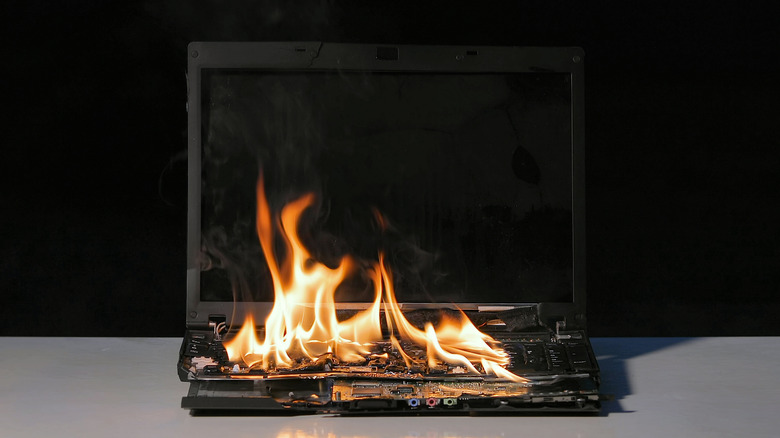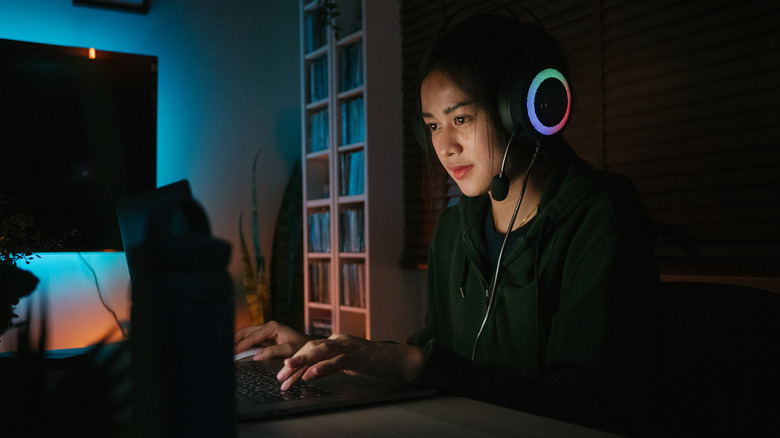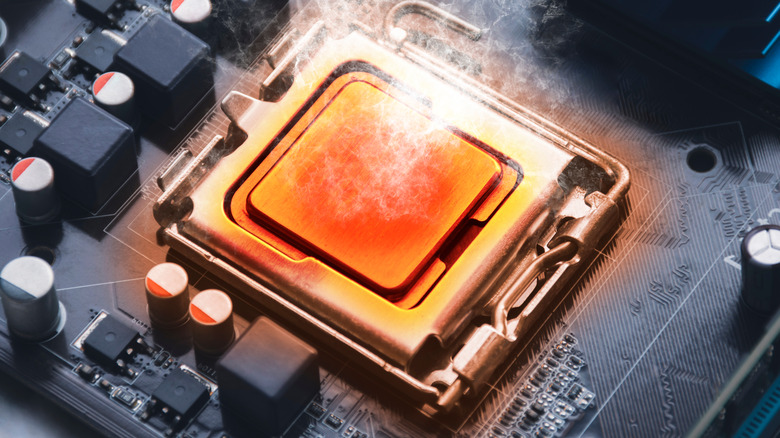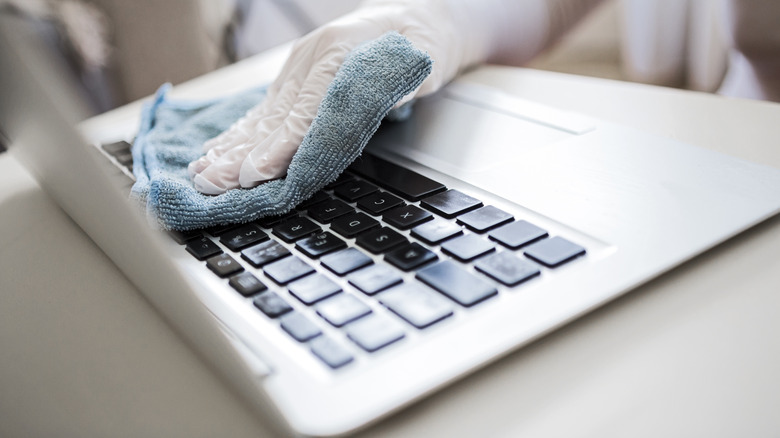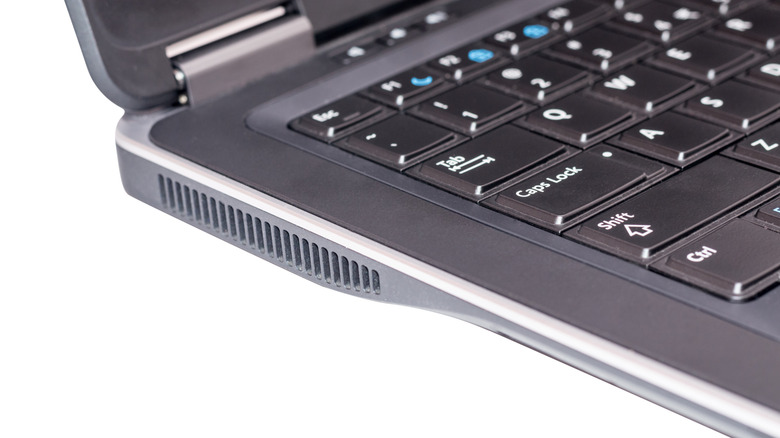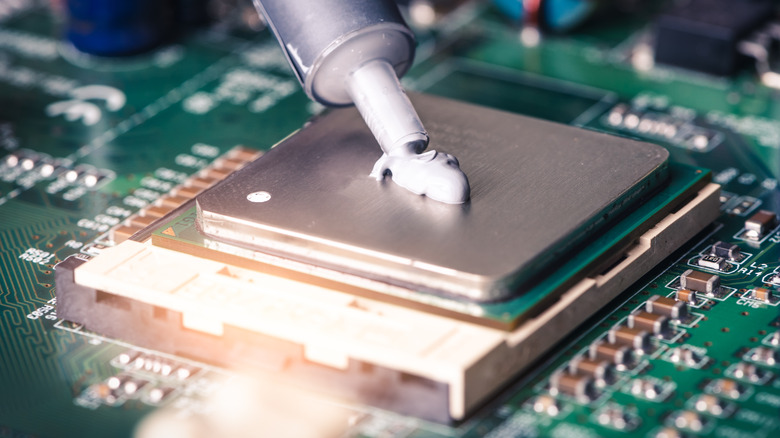How To Tell If Your Gaming Laptop Is Overheating (And How To Fix It)
We may receive a commission on purchases made from links.
Gaming laptops have come a long way in recent years. This is largely because dedicated GPU manufacturers have gotten good at taking powerful graphics cards and finding ways to slim them down to the point where they can fit inside a narrow enough case that you can still fold up and stick them in a backpack. It's certainly an impressive feat of engineering. That doesn't mean that these slimmer builds come without consequences though.
Graphics cards themselves are already quite slim. The problem is that the ones that draw more power — the kind needed for high-performance gaming such as Nvidia's new 40-series GPUs — typically need bulky cooling solutions to keep them from overheating and destroying themselves. This is simpler in a midsized tower, but there isn't a lot of space for that in a laptop. Graphics engineers have come up with a number of clever solutions for keeping these units cool despite the spatial limitations, but overheating is still quite a common phenomenon. CPUs are usually better at keeping cool, but they can overheat too, which can also cause a bunch of problems.
If you've noticed that your gaming laptop isn't performing the way it should, then it might be worth looking into whether or not it's overheating. It could be lowering your computer's performance and might even cause damage to the components inside over time. Here are a few things to look for if your gaming laptop is overheating and what you can do to fix it.
Signs that your computer is overheating
There are several signs that may indicate whether or not your laptop is overheating. The first and most obvious is that the laptop itself is hot to the touch. It's normal for your laptop to get a little warm when it's under load, but it shouldn't be so hot that it's uncomfortable to touch with your bare hands. This suggests that your laptop is building up more heat than it is able to adequately dissipate. Another obvious indicator is fan noise. A light hum is normal when your computer is under load. Video games draw heavily on your graphics card and fans are supposed to spin to help keep things cool. That said, it's not normal for your fans to be spinning at top speed for long lengths of time. This is usually very noisy, and indicates that the fans are not able to keep up with the amount of heat your CPU and/or GPU are generating.
You also might see signs of overheating in the games themselves. Sometimes GPUs and CPUs will throttle in order to protect themselves against damage from the heat they're producing. Try keeping an FPS tracker open while gaming in order to see if your frame rates start to dip after you've been playing for a little while.
Verify heat levels of individual components
It's always good to keep an eye out for signs of overheating, but you might also want to take a look at the temperatures of the components themselves so you can pinpoint if there is a specific part that is the source of the problem.
Checking the GPU is easy to do on Windows. All you have to do is hold down CTRL+ALT+DEL and select Task Manager. Then select the 'Performance' tab at the top of the window. This will show you several of your laptop's internal components, including the GPU. Take a look at the section where your GPU is listed. This should tell you what percentage of the processing unit is in use, how much of its memory is being used, and most importantly, what its current temperature is. According to WebPC, "Most GPUs are designed to withstand temperatures beyond 90 °C, so don't sweat it if yours is averaging 75 °C." That said, GPUs can handle up to 100 °C over a short period of time.
Looking at the CPU's temp is a little more complicated. To do that, you need to download external software like Core Temp or NZXT's CAM software. Monitor your GPU and CPUs temperature while you're playing one of your more graphically intensive games and see how high they get.
Clean out your laptop
One of the quickest and easiest ways to reduce your laptop's internal temperature is to clean it out. Dust and debris can be pulled into your laptop by the fans. This can block vents and even coat internal components, which insulate them so that they are unable to properly dissipate heat. There are a few methods for cleaning your laptop. The simplest is to use a can of compressed air.
Make sure your laptop is turned off and then blast the vents with air. This should send most of the dust, lint, and other detritus out of the computer without you even needing to open it up. Don't turn the can upside down, however. There is moisture in the bottom, and you should avoid getting the inside of your computer wet. It's also a good idea to take your computer outside before doing this since it can be quite messy. You'd be amazed how much dust will come out of a computer that hasn't been cleaned for a few months.
If you're comfortable cracking your laptop open, you can also give it a more thorough cleaning by using rubbing alcohol and a static-resistant cloth like a coffee filter. It's generally a good idea to disconnect your computer's battery before doing this in order to prevent any shorts.
Make sure your laptop is getting enough airflow
Dust isn't the only thing that can inhibit your computer's natural airflow, however. It's important that you make sure that your laptop's vents are free and clear of any obstruction that might be preventing them from getting access to the cool air it needs to cool the computer's internal components.
Poorly designed hard-shell protective cases are common offenders. They can cause all kinds of overheating issues if the shell is physically blocking airflow to the laptop's vents. If you're using one of these cases, you should check to make sure that it has cutouts where all the vents are located. If not, remove the case. This should allow air to circulate properly and cool your laptop's internal components.
Overheating issues can also stem from the kind of surfaces you use to support your laptop while you game. Placing it on a soft, plush surface like a pillow or a bed, for example, could restrict your laptop's access to air as well. A flat wood, glass, or metal surface like a desk or table is ideal. If a solid surface is unavailable, then you might consider purchasing a laptop stand or lap desk that you can place your computer on while you're using it.
Change thermal paste
If you're still having issues with it overheating, then the problem might be with the thermal paste on the GPU and/or CPU, though this is exceedingly rare. Thermal paste is a grease-like substance that goes between the dies on your processors and their attached cooling units to ensure maximum thermal conductivity. This can dry out and crack, which makes it so the contacts aren't properly connected and therefore not sufficiently dissipating heat.
This is a moderately advanced bit of maintenance that could potentially void your laptop's warranty. You should definitely consider contacting your laptop's manufacturer for a repair or replacement before cracking it open yourself if possible.
To replace the thermal paste yourself, you'll need to take off the bottom of your laptop. You might need specific tools to remove the screws if they don't have standard Phillips head screws. After that, you will have to disconnect your battery and then locate your laptop's heat sink and remove the screws holding it in place as well. Once the heatsink is off, you should see a gray paste on the heat sink itself and on the chips underneath. Use rubbing alcohol and a clean, non-static cloth like a coffee filter to clean off all of the paste from both sides. Then apply new thermal paste (like Thermal Grizzly paste from Kryonaut) in a clean line, spreading it with a credit card or plastic spatula so it covers the entire surface of the die. Finally, put the heatsink back on and reassemble your laptop.
If none of these solutions work, it may be time to consider customer service aid.
